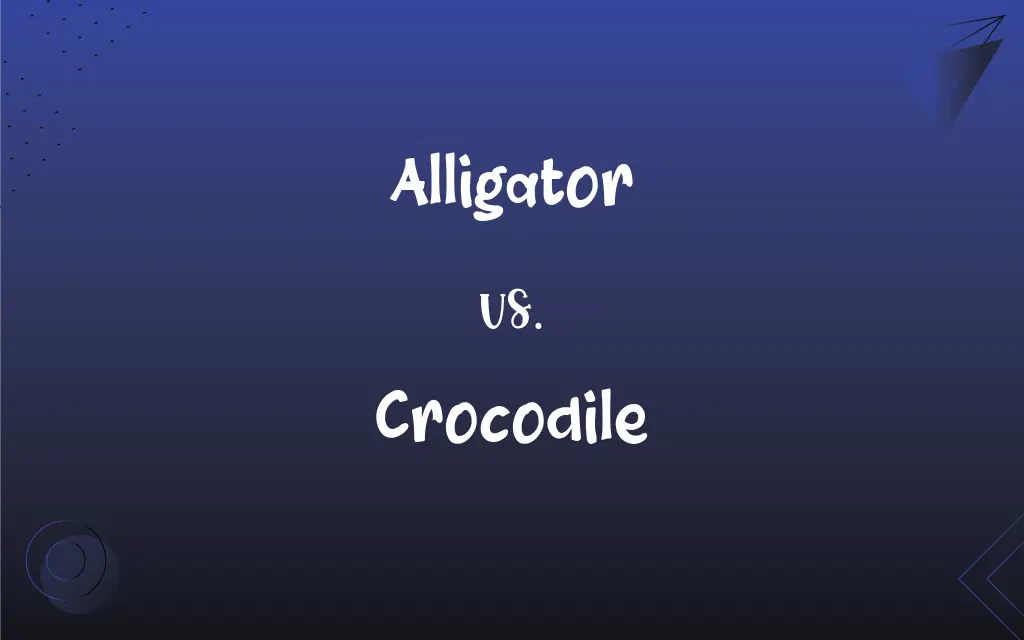Alligator vs. Crocodile: What's the Difference?
Edited by Aimie Carlson || By Janet White || Published on October 25, 2023
Alligator has a U-shaped, wider snout and black color, while Crocodile has a V-shaped, pointed snout, lighter color, and visible teeth when its mouth is closed.

Key Differences
Alligators and Crocodiles, both intriguing reptiles, garner much curiosity due to their prehistoric appearance and fearsome features. An Alligator, primarily found in parts of the US and China, often resides in freshwater habitats. Meanwhile, the Crocodile, with its notable V-shaped snout, can be found globally, spanning various continents, often preferring saltwater environments.
The physical appearances of Alligators and Crocodiles set them distinctly apart. While Alligators usually have a darker, often black complexion, Crocodiles typically have a lighter, often olive-brown skin. The broader, U-shaped snout of an Alligator generally appears more rounded, contrasting with the sharper, V-shaped snout of a Crocodile.
The disposition towards their respective environments differentiates Alligators and Crocodiles as well. Alligators tend to reside in freshwater environments, such as ponds, marshes, and lakes. On the contrary, Crocodiles prefer saltier waters, often being found in coastal habitats, and can possess glands that excrete salt, aiding in saltwater survival.
Another distinction comes in the form of their social behaviors and interactions. Alligators, often considered to be more docile towards humans, tend to avoid interactions if possible. Crocodiles, however, are often viewed as more aggressive and potentially dangerous, showcasing less hesitancy in engaging with intruders or perceived threats.
Both the Alligator and Crocodile play vital roles in maintaining ecological balance, providing numerous environmental benefits despite their fearful reputation. Alligators assist in creating ‘gator holes’ which can become lush habitats for other species, while Crocodiles, as apex predators, regulate species populations in their domains, ensuring the health and balance of their ecosystems.
ADVERTISEMENT
Comparison Chart
Snout Shape
U-shaped, wider
V-shaped, pointed
Habitat
Predominantly freshwater
Often found in saltwater habitats
Color
Typically black or very dark green
Generally olive, tan, or light brown
Teeth Visibility
Teeth are not visible when the mouth is closed
Some teeth remain visible
Geographical Spread
Primarily found in the USA and China
Distributed across various continents
ADVERTISEMENT
Alligator and Crocodile Definitions
Alligator
A pattern or style reminiscent of alligator skin.
Her alligator purse was both stylish and expensive.
Crocodile
A large predatory semi-aquatic reptile with a long, V-shaped snout.
The crocodile swiftly moved through the murky river waters.
Alligator
A large, semi-aquatic reptile with a broad snout.
The alligator basked in the sun near the swamp’s edge.
Crocodile
Representing deceit or fake tears (crocodile tears).
She didn’t trust his apology, dismissing his words as crocodile tears.
Alligator
A losing proposition in investment.
That property turned out to be an alligator, costing more than the revenue.
Crocodile
A pattern or print that resembles crocodile skin.
He wore a sleek, crocodile belt with his formal attire.
Alligator
Symbolizing hidden danger or lurking trouble.
Ignoring the warnings, she walked right into an alligator’s jaws.
Crocodile
A character or motif symbolizing danger or deception.
In the story, the crocodile cunningly tricked the monkey into becoming its meal.
Alligator
A specific type of mechanical joint or fastener.
Secure the conveyor belt using an alligator fastener for optimal performance.
Crocodile
A representation of predatory or dangerous entities.
In the film, the giant crocodile became a symbol of nature's retaliation against humanity.
Alligator
Either of two large semiaquatic reptiles, Alligator mississipiensis of the southeast United States or A. sinensis of China, having sharp teeth and powerful jaws. They differ from crocodiles in having a broader, shorter snout.
Crocodile
Any of various large aquatic reptiles of the family Crocodylidae that are native to tropical and subtropical regions and have thick, armorlike skin and long tapering jaws.
Alligator
Leather made from the hide of one of these reptiles.
Crocodile
A crocodilian reptile, such as an alligator, caiman, or gharial.
Alligator
A tool or fastener having strong, adjustable, often toothed jaws.
Crocodile
Leather made from crocodile skin.
Alligator
Either of two species of large amphibious reptile, Alligator mississippiensis or Alligator sinensis, in the genus Alligator within order Crocodilia, which have sharp teeth and very strong jaws and are native to the Americas and China, respectively.
All you could see of the alligator were two eyes above the water, then suddenly it snatched up and caught the poor bird with strong jaws full of sharp teeth.
Crocodile
Chiefly British A line of people, especially pupils or choir members, standing two abreast.
Alligator
(paleontology) A member of the family Alligatoridae, which includes the caimans.
Crocodile
Any of the predatory amphibious reptiles of the family Crocodylidae; (loosely) a crocodilian, any species of the order Crocodilia, which also includes the alligators, caimans and gavials.
Alligator
(Nigeria) dwarf crocodile (Osteolaemus tetraspis)
Crocodile
A long line or procession of people (especially children) walking together.
Alligator
(formerly) Applied to any species of crocodile.
Crocodile
(logic) A fallacious dilemma, mythically supposed to have been first used by a crocodile.
Alligator
Any of various machines with strong jaws, one of which opens like the movable jaw of an alligator.
Crocodile
(intransitive) To speak one's native language at an Esperanto-language gathering, rather than Esperanto.
Alligator
(metalworking) A form of squeezer for the puddle ball.
Crocodile
A large reptile of the genus Crocodilus, of several species. They grow to the length of sixteen or eighteen feet, and inhabit the large rivers of Africa, Asia, and America. The eggs, laid in the sand, are hatched by the sun's heat. The best known species is that of the Nile (Crocodilus vulgaris, or Crocodilus Niloticus). The Florida crocodile (Crocodilus Americanus) is much less common than the alligator and has longer jaws. The name is also sometimes applied to the species of other related genera, as the gavial and the alligator.
Alligator
(mining) A rock breaker.
Crocodile
A fallacious dilemma, mythically supposed to have been first used by a crocodile.
Alligator
(printing) A kind of job press.
Crocodile
Large voracious aquatic reptile having a long snout with massive jaws and sharp teeth and a body covered with bony plates; of sluggish tropical waters
Alligator
Any of various vehicles that have relatively long, low noses in front of a cab or other, usually windowed, structure.
Alligator
(obsolete) One who binds or ties.
Alligator
To crack in a pattern resembling an alligator's skin.
Alligator
Used in a common chronometric counting scheme, in which the speaker counts out loud, saying the word "alligator" between the numbers so that each number is spoken approximately one second after the last one.
Alligator
A large carnivorous reptile of the Crocodile family, peculiar to America. It has a shorter and broader snout than the crocodile, and the large teeth of the lower jaw shut into pits in the upper jaw, which has no marginal notches. Besides the common species of the southern United States, there are allied species in South America.
Alligator
Any machine with strong jaws, one of which opens like the movable jaw of an alligator
Alligator
To form shallow cracks in a reticulated pattern on the surface, or in a coating on the surface, of an object.
Alligator
Leather made from alligator's hide
Alligator
Either of two amphibious reptiles related to crocodiles but with with shorter broader snouts
Alligator
Of paint, varnish, or the like: to crack and acquire the appearance of alligator hide, as from weathering or improper application
FAQs
What is a Crocodile?
A crocodile is a reptile that belongs to the family Crocodylidae, known for its long, V-shaped snout and often inhabiting saltwater regions.
Why is an Alligator's snout U-shaped?
The U-shaped snout of an alligator is adapted for a diet that includes more shellfish, aiding in crushing prey.
Where are Crocodiles located?
Crocodiles have a wide global distribution, spanning continents like Africa, Asia, Australia, and the Americas, primarily in tropical regions.
Where can Alligators be found?
Alligators are primarily found in the southeastern United States and the eastern part of China.
Are Alligators aggressive?
Generally, alligators are considered to be less aggressive than crocodiles, often avoiding human interactions when possible.
Why do Crocodiles have a V-shaped snout?
Crocodiles have a V-shaped snout that is adapted for a diet consisting more of fish, enabling them to cut through the water cleanly to catch prey.
How long can Crocodiles live?
Crocodiles can live for up to 70 years or more, depending on the species and environmental factors.
What is an Alligator?
An alligator is a large, semi-aquatic reptile with a broad, U-shaped snout, belonging to the family Alligatoridae.
Are Crocodiles dangerous to humans?
Yes, crocodiles are considered to be more aggressive and can be dangerous to humans, exhibiting less fear and more predatory behavior.
How large can an Alligator grow?
Alligators can grow to be approximately 8.2 to 11.2 feet (2.5 to 3.4 meters) in length.
What is the lifespan of an Alligator?
Alligators can live for around 30-50 years in the wild, potentially longer in captivity.
Are Crocodiles found in freshwater habitats?
Yes, crocodiles can be found in freshwater habitats but they are well-adapted to living in saltwater as well.
How fast can an Alligator move?
Alligators can run up to 11 miles per hour (18 kilometers per hour) and swim up to 20 mph (32 kph).
How fast can a Crocodile swim?
Crocodiles are swift swimmers and can reach speeds up to 22 miles per hour (35 kilometers per hour).
Can Alligators live in saltwater?
Alligators primarily live in freshwater but can tolerate saltwater for brief periods.
How large can a Crocodile grow?
Crocodiles can grow significantly large, with some species reaching lengths of up to 20 feet (6 meters) or more.
What do Alligators eat?
Alligators have a varied diet that includes fish, amphibians, reptiles, birds, and mammals.
How do Alligators reproduce?
Alligators reproduce through laying eggs, which the female guards until they hatch.
How do Crocodiles reproduce?
Crocodiles lay eggs in nests made of vegetation or in sandy banks and the level of parental care can vary among species.
What is a Crocodile’s diet?
Crocodiles are carnivorous, eating fish, birds, mammals, and occasionally smaller crocodiles.
About Author
Written by
Janet WhiteJanet White has been an esteemed writer and blogger for Difference Wiki. Holding a Master's degree in Science and Medical Journalism from the prestigious Boston University, she has consistently demonstrated her expertise and passion for her field. When she's not immersed in her work, Janet relishes her time exercising, delving into a good book, and cherishing moments with friends and family.
Edited by
Aimie CarlsonAimie Carlson, holding a master's degree in English literature, is a fervent English language enthusiast. She lends her writing talents to Difference Wiki, a prominent website that specializes in comparisons, offering readers insightful analyses that both captivate and inform.
































































